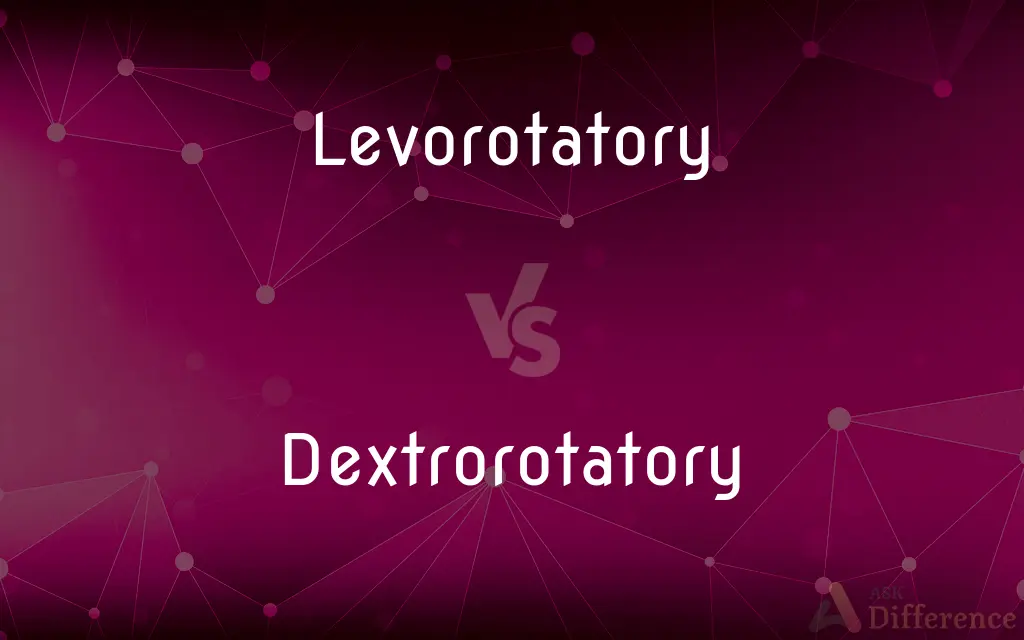Levorotatory vs. Dextrorotatory — What's the Difference?
By Tayyaba Rehman — Updated on November 1, 2023
Levorotatory substances rotate polarized light to the left, dextrorotatory to the right.

Difference Between Levorotatory and Dextrorotatory
Table of Contents
ADVERTISEMENT
Key Differences
Levorotatory compounds are characterized by their ability to rotate plane-polarized light counterclockwise when viewed from the receiver. Dextrorotatory compounds, however, rotate plane-polarized light clockwise. The direction of light rotation is a fundamental property of chiral molecules in these substances.
In the field of chemistry, levorotatory is denoted by the prefix '(-)' or 'l-', indicating left-handed rotation. Dextrorotatory is represented by '(+)' or 'd-', signifying right-handed rotation. These prefixes are used to describe the optical activity of the molecules.
The levorotatory and dextrorotatory nomenclatures are crucial in stereochemistry, where the three-dimensional arrangements of atoms can cause differing reactions, even if the compounds share the same structural formula. For example, a levorotatory amino acid may have different biological activity compared to its dextrorotatory counterpart.
The optical rotation displayed by levorotatory substances can be measured using polarimeters, as is the case for dextrorotatory substances. The measurements obtained help in determining the enantiomeric purity of a given compound, which is essential in fields like pharmaceuticals.
Understanding whether a substance is levorotatory or dextrorotatory is vital for applications in pharmacology, where the efficacy and safety of a drug can depend on its optical isomerism. Each behaves distinctly in biological systems, leading to different pharmacokinetics and pharmacodynamics.
ADVERTISEMENT
Comparison Chart
Direction of Rotation
Counterclockwise (left)
Clockwise (right)
Symbol
(-), l-
(+), d-
Perception from Receiver
Viewed as rotating left
Viewed as rotating right
Common in Nature
Less common than dextrorotatory
More common than levorotatory
Impact in Pharmacology
Different biological activity
Different biological activity
Compare with Definitions
Levorotatory
Left-handed chiral molecules
Levorotatory enantiomers often have different smells.
Dextrorotatory
Rotates light clockwise
The dextrorotatory substance polarized light in a rightward spiral.
Levorotatory
Rotates light counterclockwise
The levorotatory form of the molecule was less effective than expected.
Dextrorotatory
Right-handed chiral molecules
Dextrorotatory compounds are sometimes synthesized for medication.
Levorotatory
Optical isomer rotating to the left
Lactic acid is found in a levorotatory form in sour milk.
Dextrorotatory
Denoted by a plus sign
Glucose is typically dextrorotatory, indicated by its '(+)' sign.
Levorotatory
Denoted by a minus sign
The substance was identified as levorotatory with a negative optical rotation.
Dextrorotatory
Optical isomer rotating to the right
Orange peels contain dextrorotatory limonene.
Levorotatory
Counterpart to dextrorotatory
In some drugs, the levorotatory isomer is the active ingredient.
Dextrorotatory
Counterpart to levorotatory
The dextrorotatory enantiomer was inactive in the body.
Levorotatory
Of or relating to an optically active substance that rotates the plane of polarized light to the left, or counterclockwise (when looking toward the light source)
Only levorotatory amino acids are biologically active.
Dextrorotatory
(of a compound) having the property of rotating the plane of a polarized light ray to the right, i.e. clockwise facing the oncoming radiation.
Levorotatory
That rotates the plane of polarized light to the left, or anticlockwise. Notation: (−) or formerly lowercase l-#Prefix.
Levofloxacin is the levorotatory enantiomer of the medication ofloxacin.
Dextrorotatory
Of or relating to an optically active substance that rotates the polarization of light to the right, or clockwise (when looking toward the light source)
A dextrorotatory solution.
Levorotatory
Turning or rotating the plane of polarization of light towards the left; - applied to crystals and compounds exhibiting optical activity, such as levulose, left-handed quartz crystals, etc. Opposite of dextrorotatory.
Dextrorotatory
That rotates the plane of polarized light to the right, or clockwise. Notation: (+) or formerly lowercase d-#Prefix.
Dexibuprofen is the active dextrorotatory enantiomer of ibuprofen.
Levorotatory
Rotating to the left
Dextrorotatory
Turning, or causing to turn, toward the right hand; esp., turning the plane of polarization of luminous rays toward the right hand; as, dextrorotatory crystals, sugars, etc. Cf. Levorotatory.
Dextrorotatory
Rotating to the right
Common Curiosities
How are levorotatory compounds denoted?
They are denoted with a '(-)' or 'l-' prefix.
What does levorotatory mean?
Levorotatory refers to a compound that rotates polarized light to the left.
Can levorotatory and dextrorotatory compounds have the same chemical structure?
Yes, but they are mirror images of each other.
What is a dextrorotatory compound?
A dextrorotatory compound rotates polarized light to the right.
Is optical rotation a physical or chemical property?
It is a physical property.
Why is it important to distinguish between levorotatory and dextrorotatory?
Because they can have different biological effects.
What does the '(+)' signify in a compound's name?
It indicates the compound is dextrorotatory.
Does levorotatory mean the same as S-configuration?
Not always; levorotatory refers to optical activity, while S-configuration refers to the spatial arrangement of atoms.
Do all substances exhibit optical rotation?
No, only chiral substances have this property.
Can the optical rotation of a substance change?
Yes, through chemical reactions or interactions with other compounds.
Do levorotatory and dextrorotatory refer to specific substances?
No, they refer to properties that different substances can have.
Are levorotatory and dextrorotatory terms used outside chemistry?
They are primarily used in chemistry and related sciences.
Is glucose levorotatory or dextrorotatory?
Glucose is dextrorotatory.
How do you measure optical rotation?
Using a polarimeter.
Share Your Discovery

Previous Comparison
Hawk vs. Hock
Next Comparison
Askew vs. EschewAuthor Spotlight
Written by
Tayyaba RehmanTayyaba Rehman is a distinguished writer, currently serving as a primary contributor to askdifference.com. As a researcher in semantics and etymology, Tayyaba's passion for the complexity of languages and their distinctions has found a perfect home on the platform. Tayyaba delves into the intricacies of language, distinguishing between commonly confused words and phrases, thereby providing clarity for readers worldwide.
















































